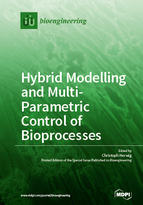Hybrid Modelling and Multi-Parametric Control of Bioprocesses
A special issue of Bioengineering (ISSN 2306-5354).
Deadline for manuscript submissions: closed (30 June 2017) | Viewed by 84798
Special Issue Editor
Interests: biopharmaceutical process development
Special Issues, Collections and Topics in MDPI journals
Special Issue Information
Dear Colleagues,
The goal of bioprocessing is to optimize process variables, such as product quantity and quality, in a reproducible, scalable, and transferable manner. However, bioprocesses are highly complex. A large number of process parameters and raw material attributes exist, which are highly interactive, and may vary from batch to batch. Those interactions need to be understood, and the source of variance must be identified and controlled.
While purely data-driven correlations, such as chemometric models of spectroscopic data, may be employed for the understanding how process parameters are related to process variables, they can hardly be deployed outside of the calibration space. Currently, mechanistic models, models based on mechanistic links and first principles, are in the focus of development. They are perceived to allow transferability and scalability, because mechanistics can be extrapolated. Moreover, the models deliver a large range of hardly-measureable states and physiological parameters.
For implementation of mechanistic models, however, models need to be simplified and linked to process parameters for real time execution. For this, hybrid models, and hence links between Data Driven and Mechanistic Models, may be a helpful solution.
Moreover, models need to be deployed in the control context: Bioprocesses need to be controlled on the one hand on different parameters simultaneously (e.g., constant precursor concentration and specific growth rate) and, on the other hand, may have different objective functions (maximum productivity and correct product quality). Hence, novel solutions and case studies for multiple input and output controls need to be developed, as they already exist in other market segments.
The current Special Issue wants to display current solutions and case studies of development and deployment of hybrid models and multi-parametric control of bioprocesses. Pure data driven solutions are discouraged. The Special Issue is open for any kind of bioprocess. Therefore, we seek contributions that address, for example:
- Hybrid model solutions, combinations of data driven and mechanistic models.
- Workflows how mechanistic models can be developed from data driven approaches and vice versa.
- Discussion between explorative (DoE-based) and model based experimental design
- Implementation of hybrid models in the real-time context
- Models as PAT tool: Demonstrations of cases in which models were a solution to measure less
- Observer solutions for real-time parameter optimization
- Multiparametric control and event prediction
- Life Cycle management of models
- Knowledge management using hybrid models
Prof. Dr. Christoph Herwig
Guest Editor
Manuscript Submission Information
Manuscripts should be submitted online at www.mdpi.com by registering and logging in to this website. Once you are registered, click here to go to the submission form. Manuscripts can be submitted until the deadline. All submissions that pass pre-check are peer-reviewed. Accepted papers will be published continuously in the journal (as soon as accepted) and will be listed together on the special issue website. Research articles, review articles as well as short communications are invited. For planned papers, a title and short abstract (about 100 words) can be sent to the Editorial Office for announcement on this website.
Submitted manuscripts should not have been published previously, nor be under consideration for publication elsewhere (except conference proceedings papers). All manuscripts are thoroughly refereed through a single-blind peer-review process. A guide for authors and other relevant information for submission of manuscripts is available on the Instructions for Authors page. Bioengineering is an international peer-reviewed open access monthly journal published by MDPI.
Please visit the Instructions for Authors page before submitting a manuscript. The Article Processing Charge (APC) for publication in this open access journal is 2700 CHF (Swiss Francs). Submitted papers should be well formatted and use good English. Authors may use MDPI's English editing service prior to publication or during author revisions.
Keywords
- mechanistic and hybrid models
- real-time implementation
- multi-parametric control of bioprocesses
- model base experimental design
- life cycle management of and knowledge management by models







